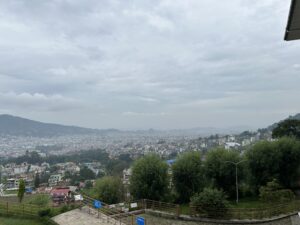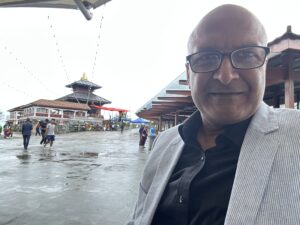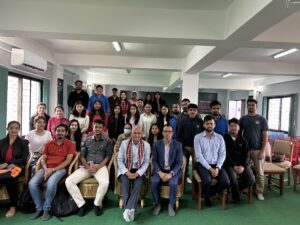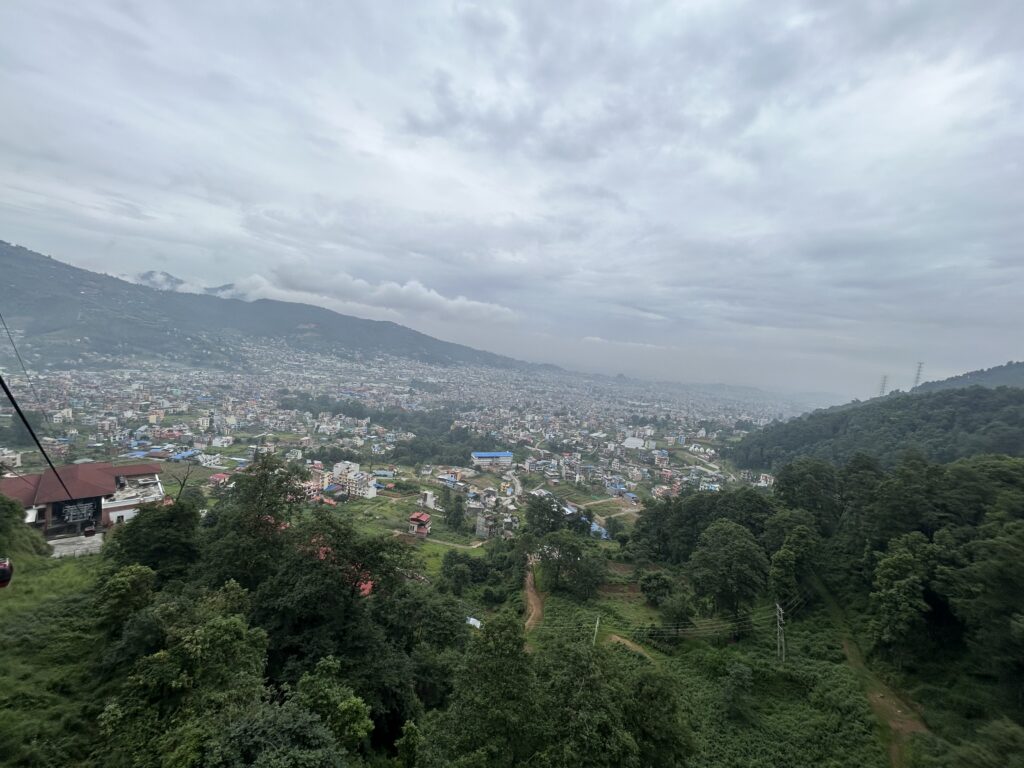I had been thinking of visiting Kathmandu for a long time. In the past, I had the opportunity to visit a few towns like Mahendranagar and Biratnagar in Nepal – both share their boundaries with India – but for a very short time. I was acquainted with some students from Nepal who I taught when I started my teaching career. Later, I also made some friends with a few professors who worked in the universities of Nepal.
Much to my delight, I was approached for some work recently by the Dean of the Faculty of Management at Tribhuvan University, Kathmandu, and happily agreed to visit.
I spent around 9 years of my teaching career in a small country named Bhutan. It was a monarchy then (Bhutan adopted constitutional democracy in 2008). Similarly, Nepal had been ruled by heredity Kings for several centuries. While Bhutan has Buddhism as a state religion and Nepal has been a Hindu nation (in 2006, Nepal embraced democracy and declared itself as a secular nation), one can see lot of Buddhists who are citizens of Nepal, quite the same as there are Nepalese (called as Lhoshampas in Bhutan) who are citizens of Bhutan.
In the latter half of the last decade, I got involved in the study of the South Asian region as I was writing a book chapter on the trends and history of human well-being in South Asia. This chapter was later expanded into a book which necessitated a deeper delineation of the region, its history, development, and society. Through visiting libraries, browsing on the web, and reading, an understanding was developed which I could document in my book. However, it has always been my desire to visit countries falling in the South Asian region so that I have firsthand experience to make some little observations, comparisons, and reflections on issues that are important in exploring human well-being, happiness, public policy, and progress potential.
Kathmandu looks like a familiar city due to racial connectedness, linguistic similarity, familiar religious rituals, and understandable signages. It is surrounded by Lalitpur on one side and Bhaktapur on the other side and falls under the Bagmati province. Around seven percent of the Nepalese population resides in Kathmandu dominated by Newars.

The view of Kathmandu valley from Chandragiri hill was amazing. The view was far wider as compared to the view of Shillong valley from the Laitkor viewpoint, situated in upper Shillong (Meghalaya). I could not help but remember how Shillong looked from the top. As ill luck would have it, when I reached Chandragiri hill view, it was all cloudy. Tantrums of the colony of clouds reminded me of the ones I witnessed during my stay in Meghalaya (abode of clouds).
When I was leaving the hotel for Chandragiri viewpoint, the driver informed me that it would be terribly cold and advised me to carry a cap and a jacket. He also told me that many people who go there end up with a runny nose. As I had not taken any woolen clothes, I had to make do with only a cotton blazer I was carrying. After we reached the point from where I was to take the ropeway, he gave me some instructions to prepare for the cold above. The tickets there were for three groups of people – for Nepalese, for SAARC nationals, and for other foreigners.
 The ropeway ride was managed excellently well and the cleanliness maintained by the company (Chandagiri Hills Ltd) needs to be appreciated. The Bhaleswar Mahadev temple located at this site seemed to attract a lot of pilgrims as it has historical importance attached to it through the legends of the past Kings and their valour. On reaching back to the taxi stand and travelling to town I told the driver that it was warm up there and there was no wind. He was amused and taken by surprise.
The ropeway ride was managed excellently well and the cleanliness maintained by the company (Chandagiri Hills Ltd) needs to be appreciated. The Bhaleswar Mahadev temple located at this site seemed to attract a lot of pilgrims as it has historical importance attached to it through the legends of the past Kings and their valour. On reaching back to the taxi stand and travelling to town I told the driver that it was warm up there and there was no wind. He was amused and taken by surprise.
On the ropeway drive I happened to meet a young student pursuing BBA hailing from a far off place in Nepal. He told me that his father ran a rice mill in the village. This young boy had an iPhone XR and wanted to go abroad for undergraduate studies. Unfortunately, he was denied a visa, so he had to stay back and pursue the course in Nepal itself. He still dreamt of going to Canada through PTE (Pearson Test of English).
I am told that many young people aspire to go abroad for studies since they see a bleak future in Nepal. Exploring better pastures of life is a welcoming trend, however being thankless to one’s nation and escaping from one’s responsibility to improve national well-being is not appreciative. There could be many factors that drive the youth to think like this. It is the responsibility of the state not to ignore these factors. It needs to put efforts to win the confidence of the youth who are the future of any country.

I was informed that Tribhuvan University is the oldest university of Nepal out of some 17 government run universities there. It has over half a million students out of which around one third are under the school of management pursuing BBA, MBA, BBS, MTTM, and similar courses. They do not have core commerce programs. There are three types of colleges – constituent colleges, community colleges, and private colleges. All these colleges fall under one or the other university for their academic and/or administrative control, as the case may be. The doctoral programs offered by all these universities charge heavy fees which in a way restricts entry but also denies the opportunity to many who might be genuinely concerned to pursue research.
There seemed to be high respect for people having or pursuing a doctoral degree. The van driver who brought me from the hotel to the airport in Kathmandu folded his hands, greeted me and. He was very polite and respectful throughout our conversations and also guided some of my views on religious beliefs, education, and nationalism. In Nepal the system of doctoral programs is highly delegated and the Dean and their office seemed to play a key role in the whole process – of registering the candidate, allotment of the supervisor, monitoring the progress of research, finalising the thesis examiners, conducting the viva-voce exam, and awarding of the degree, is managed and controlled by the office of the dean.
Many of the Nepalese academics have pursued their higher education in India. One of my friends from Nepal who has retired from a government university here and is now involved with a private college, did his doctorate from the commerce department, Delhi University. He told me that he used to conditionally insist that all his doctoral students must visit the Ratan Tata Library, in the Delhi School of Economics. He fondly remembered his university days and told me that when he was pursuing his doctoral work, there were many Nepalese people who were pursuing PhD from Delhi University. I happened to meet some of them over dinner.
Their anecdotes, experiences, and interesting tales of hostel days and traveling experiences enthralled me, and their sense of appreciation and acknowledgement for Indian academia made me feel proud.
I can not make any value judgement about a country or its people based on such a short stay. Yet my observations might help visitors, policy makers, and other stakeholders when it comes to better understanding of South Asia as a region. A major hurdle to the development of Nepal has been its political instability and loss of trust of people in political parties. The comparison between the period of monarchy and democratic structure compelled me to ponder over the ill effects of democracy. When I saw a taxi driver shouting at police personnel in a crowded lane of Kathmandu, I realised that the fear of punishment for disobeying rules had taken a toll. Freedom should make people responsible and democracy should empower citizens. I realised that freedom has a price.
The trust of educated people in political parties and their rule is slowly fading. Kathmandu Metropolitan City has an independent Mayor who is an engineer by profession but popular as a hip-hop rapper. He enjoys the trust of his people and is trying his best to make the city clean, green, and prosperous. He is easily approachable and keeps all political parties at equal distance. This is positive politics and I feel that it is a good lesson for the political parties who have compromised their citizens’ well-being and have become wealthy themselves.
India has been a key development partner of Nepal. Kathmandu is the capital city of Nepal, driving youth aspirations of all Nepalese far and beyond. Hence its progress and prosperity matters, for them, us, and all.

3 thoughts on “KATHMANDU DIARY”
Quite a perspective and a intriguing viewpoint touching upon the psyche of both the nation and it’s students. Reading it feels like I’m myself taking on the journey, the objective of any travelogue.
Nice description sir. One thing I would like to add that Nepalese have a great respect for kings. They consider king Bir Bikram Shas as the incarnation of lord Vishnu and their names are inscribed on the back of pashupati nath temple. Besides, now since when democracy is born there, infrastructure seem to be improving. Otherwise, so many issues and problems like poor infra, employment and education was not properly paid attention by royals..
Dear Professor Shrotryia, Reading your blog post was a flashback for me. I was associated with the Management Department of Tribhuwan University popularly known as TU at Kirtipur Campus Kathmandu as a Colombo Plan Professor of Management from November 1986 to December 1969. Professor Rastogi from Punjab University Chandigarh was the other professor deputed by the Ministry of External Affairs under Colombo Plan. Department was set up that time in Gandhi Bhawan and later shifted to another block. Professor Rajbahak, Professor Karna, Professor Pant, Professor Ram Shakti Maskey, Professor Shrestha, Professor Salik Ram Koirala were some of the faculty members in Management Department, who were from Nepal at Kirtipur campus at that time. Kirtipur campus was a beautiful place and it was always a pleasure to go and teach there. I had a very pleasant association of about 1 year 1 month, which had to be cut short from the minimum of two years’ deputation, as my university was not prepared to allow me to stay any more. They needed my services as the Dean of College of Commerce and Management in M L S University Udaipur. Later Professor Salik Ram Koirala came to MLSU for his doctoral research. I too had gone once thereafter to TU for the viva voce of one of his students and the opportunity to meet and greet former colleagues. I recall the Rector, the Dean Research and the Dean Faculty were present at the viva voce. Later I was also invited for some lectures at the FDP by the TU.